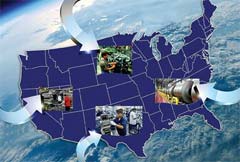Over the past decade, the US has lost millions of manufacturing jobs, some of that the result of companies moving sourcing to low costs countries, notably of course China.
Supply Chain Digest Says... |
|
|
Over the past decade or so, there have been periodic predictions that due to any of a number of factors, many companies would move to keep production domestic, or return offshored sourcing back to US shores, in a movement often called reshoring.
But despite those hopes and occasional anecdotal reports of companies here and there taking such reshoring strategies, the numbers tell the real tale.
In December, for example, US manufacturing output came in at an index level of 100.6, according the monthly report from the Federal Reserve Bank. That means US manufacturing was just barely above the baseline year of 2012 (index is set at 100) now a decade later.
Of course, the Trump administration thought it could use tariffs on billions of dollars in annual imports from China to reduce those imports in favor of US production.
It hasn’t worked out that way. Despite the Biden administration leaving those tariffs in place, the Commerce Department announced last week that the US trade deficit in goods in November hit an all-time monthly record of $99 billion.
Nevertheless, some believe the experience of the pandemic, in which there have been significant disruptions in supply from offshore vendors, along with soaring costs to ship goods to the US by boat or plane, will push companies at last to bring production back home.
For an article last week in the New York Times (Nelson D. Schwartz) takes a look at the latest bullish view on reshoring.
It cites fairly recent examples of the trend, including:
• General Motors disclosed in December that it was considering spending upward of $4 billion to expand electric vehicle and battery production in Michigan
• Also in December, Toyota announced plans for a $1.3 billion battery factory in North Carolina scheduled to employ 1,750 people
• In October, Micron Technology said it planned to invest more than $150 billion in memory chip manufacturing and research and development over the next decade, some of that to be spent in the US
• In November, Samsung said it would build a $17 billion semiconductor plant in Texas, its largest US investment to date
(Article Continues Below)
|
CATEGORY SPONSOR: SOFTEON |
|
|
| |
|
|
Stating the bullish case, Claudio Knizek, global leader for advanced manufacturing and mobility at consulting firm EY-Parthenon, tells the Times that efforts to relocate manufacturing have accelerated, and that “It may have reached a tipping point.”
Of course, we’ve heard such optimism in the past, which turned out to be out of place.
However, “It’s absolutely about being close to customers,” Tim Ingle, group vice president for enteerprise strategy at Toyota Motor North America, told the Times relative to its planned new battery plant. “It’s a big endeavor, but it’s the future.”
 Another difference this time: greater attention to the Green angle of domestic sourcing, where companies can reduce the high CO2 emissions from shipping goods from offshore. Another difference this time: greater attention to the Green angle of domestic sourcing, where companies can reduce the high CO2 emissions from shipping goods from offshore.
Also a factor: more broad recognition generally and by governmennt officials of the risk posed to the US from high levels of sourcing from China for everything from computer chips to pharmaceutical ingredients to personal protective equipment.
Experts also say any such reshoring movement will be product category-specific. Most likely to be reshored are more complex and/or expensive products, such those in the automobile, semiconductor, defense, aviation and pharmaceuticals sectors.
Simple, less expensive goods such as apparel or toys are much less likely to see US production.
Still, the Times piece tells the story of America Knits, a company trying to make a go of producing t-shirts in Georgia, from locally sourced cotton. The company currently employs 65 workers.
In an area once full of apparel and textile manufacturing facilities, so far America Knits is the only apparel company operating in the region.
“I’m the only one, the only crazy one,” says co-founder Steve Hawkins.
Despite of a bit of a wake-up call from the supply chain disruptions since the pandemic, the usual hurdles remain, including supply ecosystems no longer present in the US and the low cost of offshore labor.
“If the experts are correct, these moves could reverse decades of dwindling employment in American factories,” Times’ piece concludes.
SCDigest says: Let's hope so, but we’ve heard this one once or twice before.
Will we really see significant reshoring this time? Let us know your thoughts at the Feedback section below.
Your Comments/Feedback
|